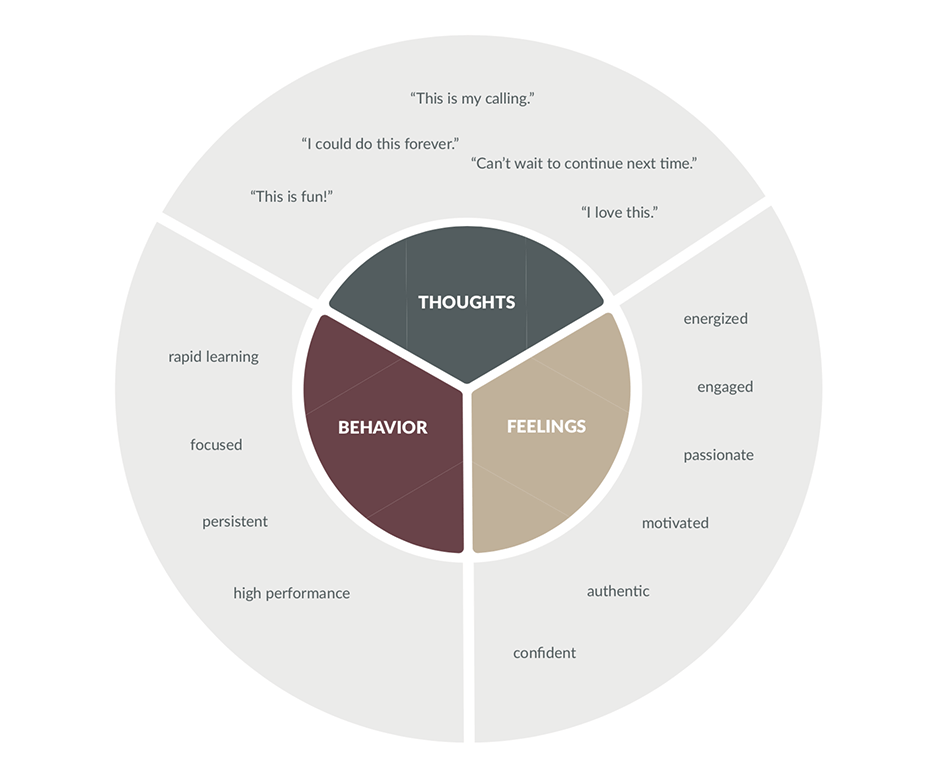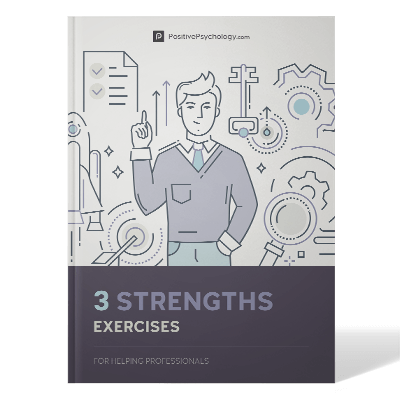Strength-Spotting Interviews: 20+ Questions and Techniques
 How often have we asked ourselves:
How often have we asked ourselves:
Who am I?
The existentialist philosopher Jean-Paul Sartre spent most of his career pondering similar questions, ultimately believing that we are what we do.
But what if we feel we are a set of potentials, as yet unrealized?
Knowing and using your strengths can help bring out your potential and encourage you to be the best version of yourself.
And yet, most of us are unaware of our strengths or those of others. Our challenge is to know what they are and resolve to use them.
We have to dare to be ourselves, however frightening or strange that self may prove to be.
May Sarton
But how do we recognize those strengths in ourselves and others?
While several excellent online tools are available, there are times, especially during conversations, when spotting strengths in the moment can be incredibly valuable. Knowing what makes you feel invigorated, excited, and motivated can bring profound benefits.
In this article, we explore strength spotting and how to perform interviews, the steps involved, and the tools available.
Before you continue, we thought you might like to download our three Strengths Exercises for free. These detailed, science-based exercises will help you or your clients realize your unique potential and create a life that feels energized and authentic.
This Article Contains:
What Is Strength Spotting?
Our character strengths are – in an authentic sense – who we are and what other people see.
They are a collection of morally valued, positive traits, essential to our wellbeing and associated with the good life (Pang & Ruch, 2019).
But most of us are either unaware of our strengths or see them as something ordinary rather than exceptional (Linley, 2008). We lack self-awareness, are not connected with our identity, or are unaware of their importance.
We are poor at spotting not only our own strengths, but also those of others. We may work closely with our manager, direct reports, and even our family but fail to recognize their strengths.
However, once we do know our strengths, the exciting part is that they can be grown through a combination of awareness and effort (Biswas-Diener, Kashdan, & Minhas, 2011).
To make the best of our strengths, first we need to know them, and that is why we look at strength spotting.
1. Strength-spotting questionnaires
An easy way to get started identifying strengths is through questionnaires.
Several online questionnaires are available that provide a safe and practical way to identify and rank strengths, most notably:
a. StrengthsFinder
The Gallup Model describes strength through the lens of performance and success (Rath & Conchie, 2009).
Interviews with thousands of top performers led to the identification of 34 talent themes grouped into four categories:
| Category | Talent themes |
|---|---|
| Executing | Achiever, Arranger, Belief, Consistency, Deliberative, Discipline, Focus, Responsibility, Restorative |
| Influencing | Activator, Command, Communication, Competition, Maximizer, Self-Assurance, Significance, Woo |
| Relationship building | Adaptability, Developer, Connectedness, Empathy, Harmony, Includer, Individualization, Positivity, Relator |
| Strategic thinking | Analytical, Context, Futuristic, Ideation, Input, Intellection, Learner, Strategic |
On completion of the CliftonStrengths assessment, a report identifies your most essential talents and growth opportunities.
b. Values in Action Inventory
A review of universally valued character traits that add meaning and happiness to life led Christopher Peterson and Martin Seligman (2004) to identify 24 character strengths.
These strengths – influenced by the environment, personal interests, and other strengths – develop over time and define who we are and what others recognize in us (Niemiec & McGrath, 2019).
They are grouped under six virtues, as follows:
| Category (virtues) | Strengths |
|---|---|
| Wisdom and knowledge | Creativity, Curiosity, Judgment, Love of learning, Perspective |
| Courage | Bravery, Perseverance, Honesty, Zest |
| Humanity | Love, Kindness, Social intelligence |
| Justice | Teamwork, Fairness, Leadership |
| Temperance | Forgiveness, Humility, Prudence, Self-regulation |
| Transcendence | Appreciation of beauty and excellence, Gratitude, Hope, Humor, Spirituality |
For a free assessment of your strengths, take the Values in Action Inventory of Strengths survey.
c. Center of Applied Positive Psychology
According to Alex Linley (2008) and the Center of Applied Positive Psychology, strengths enable an individual to act authentically and perform optimally.
Their Strengths Profile scores individuals against 60 strengths grouped under four categories:
| Category | Strengths |
|---|---|
| Being | Authenticity, Centeredness, Courage, Curiosity, Gratitude, Humility, Legacy, Mission, Moral compass, Personal responsibility, Pride, Self-awareness, Service, Unconditionality |
| Communicating | Counterpoint, Explainer, Feedback, Humor, Listener, Narrator, Scribe, Spotlight |
| Motivating | Action, Adventure, Bounce-back, Catalyst, Change Agent, Competitive drive, Efficacy, Growth, Improver, Persistence, Resilience, Work ethic |
| Relating | Compassion, Connector, Emotional awareness, Empathic connection, Enabler, Equality, Esteem builder, Personalization, Persuasion, Rapport builder, Relationship deepener |
2. Spotting strengths
Taking online surveys can provide deep insights into a person’s character.
The ranked set of strengths returned can be explored to understand, recognize, and encourage growth.
Once one or more surveys have been completed, keep the results in mind while contemplating happy moments or noteworthy times of achievement.
Ponder on this question: What character strengths were present at that time?
This vital practice of self-awareness is essential to recognize strengths and when they were used. After all, despite having a biological basis and emerging from the brain, character strengths are social.
As our strength-spotting skills develop, we can recognize character strengths anywhere, anytime, without relying on the completion of a questionnaire.
3. Strength interviews
By paying close attention to verbal and nonverbal cues, strength-spotting interviews offer an organic approach to recognizing strengths. The interviewer watches and listens for changes in behavior and speech (e.g., extra smiling, widening eyes, talking more quickly, increased gesticulation, and changes in posture) to help identify strengths.
However, considerable skill is required. The interviewer has no framework, only an open-ended conversation that mirrors the language of the speaker. Nevertheless, care must be taken by the interviewer not to bring preconceptions to the interview or make judgments other than those based on verbal, physical, and voice cues.
Additionally, the client must be prepared to share experiences openly.
4. Vocabulary of strengths
One of the most significant challenges, for both client and interviewer, is the lack of awareness regarding the language of strengths.
Indeed, we are often excellent – both in general conversation and within the practice of psychology – at discussing in-depth the limitations and challenges we face, but poor at explaining what we do well.
And yet, understanding and using the appropriate language will help make general observations more concrete.
Why It Is Important to Identify Strengths

Indeed, knowing your strengths helps you to be more authentic, grow, increase your sense of wellbeing, and optimize your performance.
However, we have become accustomed to the belief that the most significant potential we have for improvement and personal development is through ‘fixing’ our weaknesses, rather than promoting our strengths.
The list of benefits from knowing and using your strengths is a long one and includes the following (Pang & Ruch, 2019; Niemiec & McGrath, 2019; Linley, 2008; Harzer & Ruch, 2016):
- Intrinsic motivation
- Increased meaning
- Coping
- Authenticity
- Positive feelings
- Improved psychological wellbeing
- Less stress and reduced depression
- Engagement and job satisfaction
But we must identify our strengths to seek growth.
In The Power of Character Strengths, Ryan Niemiec and Robert McGrath (2019) describe the process as each of us having 24 seeds, each representing a character strength.
Each seed is essential; it needs to be cared for, given water, sunlight, and good soil. Those that are ignored will not grow and will never reach their potential.
Strength spotting is not only effective at identifying strengths and becoming part of the process of growth; it also provides a positive experience, offering opportunities to connect with clients, friends, families, and colleagues.
Real-Life Example of Strengths Interviewing
Check out the following video for a real-life example of strength-spotting interviews:
10+ Steps for Your Interview
Before stepping into a strengths-interview, consider the following guidance.
Strengths-interviewing guidelines
Strengths interviewing is not a formal process with a precise and defined set of steps. Instead, it should remain dynamic, appropriate, and relevant to the situation and the audience.
The following guidelines provide useful recommendations for a successful interview.
- Acknowledge
Always acknowledge problems and painful experiences.
Allow your client to open up about what is troubling them. This will start a dialogue that can lead to a discussion of strengths. - Overcome
Overcome the reluctance of the client to talk about strengths.
Help the client to understand that discussing positive qualities is not about bragging but brings positive psychological benefits. - Be aware
- Of verbal cues
Listen to what is being said and how (e.g., improved vocabulary, more assertive, more confident, faster speaking). - Of nonverbal signs
How does the client sit? Do they smile, laugh, and make more eye contact? - Strengths are manifested in many different ways
Remain open, observe, listen. While people may have similar strengths, they may be very different in how they display them.
- Of verbal cues
- Important signs
Recognize the most important signs of using strengths:- Expressions of engagement and excitement
- Quick learner
- Heightened performance
- Enjoyment using strengths even when tired or stressed
- Tune in
Tune in to the experience and worldview of the client.
Our environment shapes our view of what it means to have strengths. - Evaluate strengths
Evaluate strengths in others and the self.
Understand how a person deals with others and with themselves; it may not be the same. Someone may be kind to others but not to themselves. - Express gratitude
Help the client to learn how to express gratitude. Using phrases such as “I really appreciate your honesty, perseverance, and creativity” can help show appreciation.
‘What’ is being said?
It is crucial during the practice of strength-spotting interviews to recognize when the client is showing their signature strengths.
Such displays take the form of expressing thoughts, behaviors, and feelings.
The following diagram, taken from the Maximizing Strengths Masterclass©, provides samples of each:
For example, persistence and high performance observed either when doing or talking about performing an activity are reliable indicators that our signature strengths are engaged.
Watch out for how a client acknowledges their strengths.
- Thoughts – “I love this.”
- Feelings – “I feel engaged, motivated, energized…”
- Behavior – “My behavior is focused, persistent, high performing…”
‘How’ is it being said?
It is equally important, sometimes more, to listen to how the client is talking.
- Do they speak more quickly?
- Are they talking more fluently?
- Are they smiling and laughing?
- Are they sitting more upright?
- Do they look focused and engaged?
- Are they using their hands more?
Develop a shared language of strengths
A robust, shared strength vocabulary will increase the ability to recognize strengths.
The following sample is taken from a more extensive list of over 200 strength labels.
- Ambitious
- Caring
- Determined
- Open
- Tolerant
However, we must be careful that the client is not overwhelmed.
There may be times, depending on the client, when a reduced vocabulary may be more appropriate, at least initially.
Over time, the process of spotting strengths becomes more natural, and you notice them more readily in your dealings with others.
5 Helpful Guiding Questions

Below is a list of five sample questions, taken from a list of 30 available in our Positive Psychology Toolkit©.
- How have you overcome challenges?
- How do your supporters help you?
- When you were at a high point in your life, what was it about that time that was different?
- What are your future hopes and dreams?
- What do you feel proud of?
4 Useful Techniques
Using your strengths should create passion in your life. Use the following techniques to ignite it and encourage it to flourish.
1. Ignite your strengths
Use the following questions to assess each strength (Niemiec & McGrath, 2019):
- What does character strength mean to you?
- What does it look and feel like?
- How could you use this strength more frequently?
- What might it look like if you use your strength successfully?
- How did it work out when you used your strength?
- Could you do anything differently?
2. Reflected best self-assessment
We often see our strengths more clearly when viewed through the eyes of those we trust.
- Collect feedback
Ask those closest about your strengths, including examples. Collect input from several different groups (e.g., friends, family, and colleagues). - Summarize the feedback
Assess the feedback. What does it tell you? What are the common themes? - Produce a picture
Use the summary to write a self-portrait of your best self.
The output can be surprising, leading you to a more complete and increasingly accurate picture of who you are. It can also feed into mindfulness practices such as visualizing your future best selves.
3. Combining self-assessment with interviewing
While on their own, self-assessment and interviewing are potent mechanisms to identify and explore strengths, it can be useful to combine them.
An initial strength-based interview can be followed by an online self-assessment (or peer assessment). The results of both can then be discussed at a follow-up appointment to agree on the best way forward.
4. Strength reflection
Once strengths are recognized and reviewed, it is essential to take time to understand when we use them and if there are any missed opportunities to put them into action.
| Timing | Action |
|---|---|
| During the day | What task or action am I performing? How do I feel? What am I thinking? Do I feel motivated, engaged, and energized? If yes, what strengths am I using? |
| At the end of the day | When did I most feel energized today? When was I performing at my best? What was I doing at the time? What strengths was I using? |
Strength-Spotting Worksheets and Tools
There are many practical tools and worksheets at PositivePsychology.com to help with strength-spotting interviews, many of which we have already encountered within this article:
- Past, Current, & Future Strengths Worksheet – four questions for the user to reflect on their strengths and use them in goal-setting
- General Strength Cards – a dozen cards featuring different strengths and their descriptions
- How To Use Your Signature Strengths – an outline of each character strength, as well as some ways to apply each in everyday life.
- Aware Explore Apply Model – a model to help the user understand their strengths, how they could be meaningful, and how to utilize them.
- Overuse of Character Strengths – to help the user enhance their awareness of possible strength overuse (in terms of frequency, situation, or degree)
- What Strengths Do Others see? – a worksheet that is useful for getting others’ perspectives on your character strengths
PositivePsychology.com Resources
Our Maximizing Strengths Masterclass© provides valuable insights into what strengths are, how to assess them, and how we best implement them to optimize performance and happiness.
Lessons 3 and 4 in Module 3 – ‘Strength Interview’ and ‘Practicing Strength Interviews’ – explore the essence of a strength interview and provide a real-life demonstration using participants. In these lessons, Dr. Hugo Alberts further explains how the strengths of an individual are best identified by interviewing them and paying attention to a wide range of verbal, physical, and voice cues associated with strengths.
If you’re looking for more science-based ways to help others develop their strengths, this collection contains 17 strength-finding tools for practitioners. Use them to help others better understand and harness their strengths in life-enhancing ways.
A Take-Home Message
Strengths define who you are and what others recognize when you are at your most authentic.
“Character is the part of your personality that other people tend to admire, respect, and cherish” (Niemiec & McGrath, 2019).
To develop and become the best version of yourself, you need to see those strengths as crucial to who you are and utilize them in everything you do.
After all, and returning to Sartre (1997), if “existence precedes essence,” then we must take responsibility for what we do. When you display your strengths, you feel invigorated, committed, passionate, and ready to flourish and build a better life.
To become more authentic, you must become a master at recognizing and growing your strengths – through awareness and effort – and create opportunities to use them.
A strong strength vocabulary can help; when used alongside strength spotting, it can open up the chance to recognize and grow your strengths rather than your weaknesses. Over time, this process becomes increasingly natural and identifying and using strengths becomes automatic, offering opportunities to connect with clients, friends, families, and colleagues.
Use strength-spotting interviews to provide deep insights into your character and those of your clients. After all, it provides an accessible and readily available means to recognize strengths in your daily activities.
Let your strengths define you.
We hope you enjoyed reading this article. Don’t forget to download our three Strengths Exercises for free.
- Biswas-Diener, R., Kashdan, T. B., & Minhas, G. (2011). A dynamic approach to psychological strength development and intervention. The Journal of Positive Psychology, 6(2), 106–118.
- Harzer, C., & Ruch, W. (2016). Your strengths are calling: Preliminary results of a web-based strengths intervention to increase calling. Journal of Happiness Studies: An Interdisciplinary Forum on Subjective Well-Being, 17, 2237–2256.
- Linley, A. (2008). Average to A+: Realising strengths in yourself and others. CAPP Press.
- Niemiec, R. M., & McGrath, R. E. (2019). The power of character strengths: Appreciate and ignite your positive personality. VIA Institute on Character.
- Pang, D., & Ruch, W. (2019). Fusing character strengths and mindfulness interventions: Benefits for job satisfaction and performance. Journal of Occupational Health Psychology, 24(1), 150–162.
- Peterson, C., & Seligman, M. E. P. (2004). Character strengths and virtues: A handbook and classification. Oxford University Press.
- Rath, T., & Conchie, B. (2009). Strengths-based leadership: Great leaders, teams, and why people follow. Gallup Press.
- Sartre, J. (1997). Existentialism and humanism. Methuen.
Let us know your thoughts
Read other articles by their category
- Body & Brain (49)
- Coaching & Application (57)
- Compassion (26)
- Counseling (51)
- Emotional Intelligence (24)
- Gratitude (18)
- Grief & Bereavement (21)
- Happiness & SWB (40)
- Meaning & Values (26)
- Meditation (20)
- Mindfulness (45)
- Motivation & Goals (45)
- Optimism & Mindset (34)
- Positive CBT (28)
- Positive Communication (20)
- Positive Education (47)
- Positive Emotions (32)
- Positive Leadership (18)
- Positive Parenting (4)
- Positive Psychology (33)
- Positive Workplace (37)
- Productivity (16)
- Relationships (46)
- Resilience & Coping (36)
- Self Awareness (21)
- Self Esteem (38)
- Strengths & Virtues (31)
- Stress & Burnout Prevention (34)
- Theory & Books (46)
- Therapy Exercises (37)
- Types of Therapy (64)





What our readers think
Very helpful and insightful!
Hi ,very informative and helpful as we deal with clients post COVID-19 emerging issues.
with regards
Interesting information.
I had a blast taking notes to this topic!
Most interestingly were the 4 Useful Techniques you presented. I can use them in the university context, were I am giving small workshops.
Amazing information Jeremy